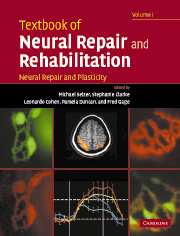Book contents
- Frontmatter
- Contents
- Contents (contents of Volume II)
- Preface
- Contributors (contributors of Volume I)
- Contributors (contributors of Volume II)
- Neural repair and rehabilitation: an introduction
- Section A Neural plasticity
- Section A1 Cellular and molecular mechanisms of neural plasticity
- Section A2 Functional plasticity in CNS system
- Section A3 Plasticity after injury to the CNS
- Section B1 Neural repair
- Section B2 Determinants of regeneration in the injured nervous system
- 21 Inhibitors of axonal regeneration
- 22 Effects of the glial scar and extracellular matrix molecules on axon regeneration
- 23 Trophic factors and their influence on regeneration
- 24 Intraneuronal determinants of regeneration
- Section B3 Promotion of regeneration in the injured nervous system
- Section B4 Translational research: application to human neural injury
- Index
21 - Inhibitors of axonal regeneration
from Section B2 - Determinants of regeneration in the injured nervous system
Published online by Cambridge University Press: 05 March 2012
- Frontmatter
- Contents
- Contents (contents of Volume II)
- Preface
- Contributors (contributors of Volume I)
- Contributors (contributors of Volume II)
- Neural repair and rehabilitation: an introduction
- Section A Neural plasticity
- Section A1 Cellular and molecular mechanisms of neural plasticity
- Section A2 Functional plasticity in CNS system
- Section A3 Plasticity after injury to the CNS
- Section B1 Neural repair
- Section B2 Determinants of regeneration in the injured nervous system
- 21 Inhibitors of axonal regeneration
- 22 Effects of the glial scar and extracellular matrix molecules on axon regeneration
- 23 Trophic factors and their influence on regeneration
- 24 Intraneuronal determinants of regeneration
- Section B3 Promotion of regeneration in the injured nervous system
- Section B4 Translational research: application to human neural injury
- Index
Summary
Introduction
The adult mammalian central nervous system (CNS) is one of the most sophisticated and intricate structures found in nature. It is also, however, one of the most delicate. Injuries to the mammalian brain or spinal cord often result in a loss of sensory and/or motor function which is invariably considered to be “untreatable”. The ancient Egyptians were the first to recognize this fact and, since then, doctors and scientists have sought to understand why, following injury, neurons of the mammalian CNS fail to regrow cut or damaged axons whereas their peripheral nervous system (PNS) counterparts often do. Research conducted in many laboratories over the past 25 years, have resulted in the elucidation of some of the causes and mechanisms of this regenerative failure and, indeed, have also suggested potential targets for therapeutic intervention thus indicating that these ailments may, in fact, not be “untreatable.”
Why do injured CNS neurons fail to regenerate? Do these neurons lose their intrinsic capacity to grow with development, or are there extrinsic factors which prevent repair? The answers to these questions appear to lie in the study of the local CNS environment. In 1981, Sam David and Albert Aguayo were the first to suggest that perhaps this lack of regeneration may not be entirely cell autonomous. Axons from damaged CNS neurons will, in fact, exhibit some regeneration if provided a permissive environment such as a peripheral nerve graft (David and Aguayo, 1981).
Keywords
- Type
- Chapter
- Information
- Textbook of Neural Repair and Rehabilitation , pp. 365 - 389Publisher: Cambridge University PressPrint publication year: 2006
- 1
- Cited by

